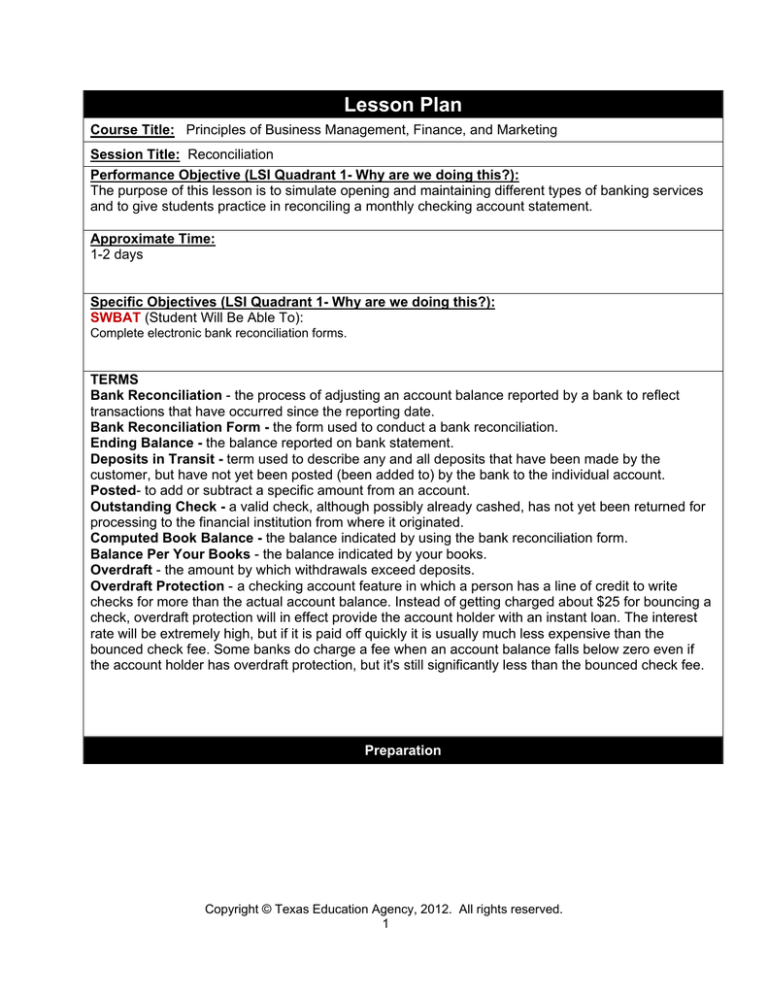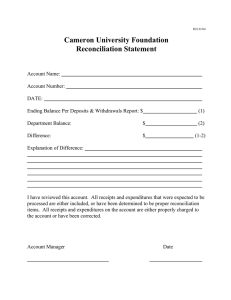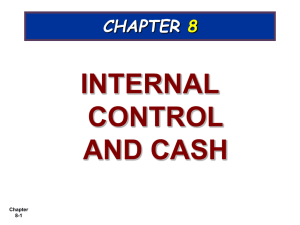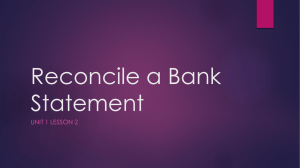Lesson Plan
advertisement

Lesson Plan Course Title: Principles of Business Management, Finance, and Marketing Session Title: Reconciliation Performance Objective (LSI Quadrant 1- Why are we doing this?): The purpose of this lesson is to simulate opening and maintaining different types of banking services and to give students practice in reconciling a monthly checking account statement. Approximate Time: 1-2 days Specific Objectives (LSI Quadrant 1- Why are we doing this?): SWBAT (Student Will Be Able To): Complete electronic bank reconciliation forms. TERMS Bank Reconciliation - the process of adjusting an account balance reported by a bank to reflect transactions that have occurred since the reporting date. Bank Reconciliation Form - the form used to conduct a bank reconciliation. Ending Balance - the balance reported on bank statement. Deposits in Transit - term used to describe any and all deposits that have been made by the customer, but have not yet been posted (been added to) by the bank to the individual account. Posted- to add or subtract a specific amount from an account. Outstanding Check - a valid check, although possibly already cashed, has not yet been returned for processing to the financial institution from where it originated. Computed Book Balance - the balance indicated by using the bank reconciliation form. Balance Per Your Books - the balance indicated by your books. Overdraft - the amount by which withdrawals exceed deposits. Overdraft Protection - a checking account feature in which a person has a line of credit to write checks for more than the actual account balance. Instead of getting charged about $25 for bouncing a check, overdraft protection will in effect provide the account holder with an instant loan. The interest rate will be extremely high, but if it is paid off quickly it is usually much less expensive than the bounced check fee. Some banks do charge a fee when an account balance falls below zero even if the account holder has overdraft protection, but it's still significantly less than the bounced check fee. Preparation Copyright © Texas Education Agency, 2012. All rights reserved. 1 TEKS Correlations: This lesson, as published, correlates to the following TEKS. Any changes/alterations to the activities may result in the elimination of any or all of the TEKS listed. 130.112(c) 12) The student demonstrates an understanding of financial management. The student is expected to: (D) reconcile bank statements Interdisciplinary Correlations: English-English 1 110.31(b)(1). Reading/Vocabulary Development. Students understand new vocabulary and use it when reading and writing. 110.31(b)(11). Reading/Comprehension of informational text/procedural texts. Students understand how to glean and use information in procedural texts and documents. Math-Algebra 1 111.xx(C)(1) Mathematical Process Standards. The student uses mathematical processes to acquire and demonstrate mathematical understanding. The student is expected to: (A) apply mathematics to problems arising in everyday life, society, and the workplace; (B) use a problem-solving model that incorporates analyzing given information, formulating a plan or strategy, determining a solution, justifying the solution, and evaluating the problem-solving process and the reasonableness of the solution; (C) select tools, including real objects, manipulatives, paper/pencil, and technology as appropriate, and techniques, including mental math, estimation, and number sense as appropriate, to solve problems. Occupational Correlation (O*Net – www.onetonline.org/ ) Job Title: Statement Clerk O*Net Number: 43-3021.01 Reported Job Titles: Data Processor, Statement Distribution Clerk, Statement Processor Tasks: Encode and cancel checks, using bank machines. Take orders for imprinted checks. Compare previously prepared bank statements with canceled checks and reconcile discrepancies. Soft Skills: Deductive reasoning, problem sensitivity, and oral comprehension. Copyright © Texas Education Agency, 2012. All rights reserved. 2 Teacher Preparation: The teacher will review the terms in the outline, presentation slides, and any handouts to become familiar with the lesson. Teacher should locate and evaluate various resources and websites before the lesson. Teacher will have assignments and website information ready to distribute to students. References: http://www.tea.state.tx.us/index2.aspx?id=6148&menu_id=720&menu_id2=785 Instructional Aids: Lesson 7.3- Reconciliation presentation Bank Reconciliation Form Materials Needed: Lesson 7.3- Reconciliation presentation Bank Reconciliation Form Equipment/Software Needed: Computers Internet Spreadsheet program Learner Preparation: Have students identify different definitions and circumstances to the term ‘reconciliation.’ Introduction Introduction (LSI Quadrant I- Why are we doing this lesson?): To give students practice in reconciling a bank statement. ASK: Have you ever reconciled a bank statement? ASK: Do you know why reconciling (formally or informally) is important? SAY: Bank reconciliations were done to help customers understand there could be a difference in Copyright © Texas Education Agency, 2012. All rights reserved. 3 what the bank thinks you have in your account and what you think you have in your account based on outstanding deposits (amounts that have not been added to your checking account balance) and outstanding checks (amounts that have not been subtracted from your checking account balance). SAY: Due to online banking and online bill pay, reconciliations are slowly becoming a ‘thing of the past. ASK: Is this statement true? Why or why not? SAY (if students aren’t sure how to answer): Due to the real time of account transactions…meaning, if you’re using online banking, outstanding deposits and debit transactions (checks/debit card) are immediately visible to the user and typically have a ‘processing’ notation...the need for officially going through the reconciling process isn’t necessary, as long as you are aware of all transactions that have occurred with your account. A good practice is to periodically check your checking account for fraudulent transactions and immediately report them to your financial institution. Some banks monitor suspicious activity, and will notify you of ones they feel are suspicious via phone calls, texts, and emails. Outline Outline (LSI Quadrant II- What are we doing in this lesson?): Instructors can use the presentation slides, handouts, and note pages in conjunction with the following outline. MI I. Outline Discovery A. Online search ‘bank reconciliation form’ II. Introduction A. Introduce the ‘why’ of the lesson 1. Why we are doing this assignment 2. Need to Know Terms Notes to Instructor Students will find a variety of links to follow, and let them look around a little bit and see if they can find any free templates from different websites. Make note they are all slightly different (some can be done by printing them out, others are electronic.) Use the provided objectives and terms by method of choice. Copyright © Texas Education Agency, 2012. All rights reserved. 4 Verbal Linguistic Logical Mathematical III. Guided Practice 1 A. Bank Reconciliation Form (template provided) B. Bank Reconciliation Worksheet (provided) Go through how to fill out the reconciliation form based on the information provided in the ‘reconciliation worksheet’ handout. IV. Independent Practice A. Bank Reconciliation Form, sheet tabs 2 and 3 Have students do 1-2 other bank reconciliations (using the same template and worksheet provided for the guided practice). V. Summary A. Ask provided questions. Use the questions provided in the presentation. Visual Spatial Musical Rhythmic Bodily Kinesthetic Intrapersonal Interpersonal Naturalist Existentialis t Application Guided Practice (LSI Quadrant III- How are we going to do this?): Have students download the Bank Reconciliation Template (spreadsheet document) and either download (or hand out to students) the Bank Reconciliation Worksheet (document). Show them how to fill out the first sheet tab. Independent Practice (LSI Quadrant III- How are we going to do this?): Have students complete sheet tabs 2 and 3 on their own. Copyright © Texas Education Agency, 2012. All rights reserved. 5 Summary Review (LSI Quadrants I- Why are we doing this lesson? and IV- Extending the lesson): To help students answer the following questions of themselves: What pieces of information are needed to reconcile a bank statement? What is a deposit in transit? What is an outstanding check? Why is it a good idea to reconcile? What happens when a person’s account overdrafts? To extend the lesson, have students find out if their parents’ bank (or a random one) has an overdraft policy and what information is in that policy? Evaluation Informal Assessment (LSI Quadrant III): Walk around and spot check students as they work on their own. Give deadlines for different stages of the assignment. Formal Assessment (LSI Quadrant III, IV): Bank Reconciliation Test Extension Extension/Enrichment (LSI Quadrant IV- Extending the lesson): To extend the lesson, have students find out if their parents’ bank (or a random one) has an overdraft policy and what information is in that policy? Copyright © Texas Education Agency, 2012. All rights reserved. 6 Formal Assessment Bank Reconciliation Test (spreadsheet Worksheet and Datasheet) Grading Rubric Item Completed ? Correct ? Title Info Bank Statement Date Deposits Balance Outstanding Checks Balance Books and Bank Balance Each item could be worth 20 points on a 100 point test, or you can weight each item differently. Copyright © Texas Education Agency, 2012. All rights reserved. 7 Monthly Bank Reconciliation [Month Day, 20XX] Bank Statement Date: $0.00 Ending Balance from Bank Statement Add Deposits in Transit: Deposit Date Amount $0.00 $0.00 $0.00 $0.00 $0.00 Deposit Date Amount $0.00 $0.00 $0.00 $0.00 $0.00 $0.00 Total Deposits in Transit $0.00 Subtotal Subtract Outstanding Checks: Check Number Amount $0.00 $0.00 $0.00 $0.00 $0.00 $0.00 $0.00 $0.00 $0.00 $0.00 $0.00 $0.00 $0.00 $0.00 $0.00 $0.00 $0.00 $0.00 $0.00 $0.00 Check Number Amount $0.00 $0.00 $0.00 $0.00 $0.00 $0.00 $0.00 $0.00 $0.00 $0.00 $0.00 $0.00 $0.00 $0.00 $0.00 $0.00 $0.00 $0.00 $0.00 $0.00 Total Outstanding Checks $0.00 Computed Book Balance $0.00 Balance per Your Books $0.00 Difference $0.00 Copyright (c) Texas Education Agency, 2012. All rights reserved. Bank Reconciliation Worksheet Data Sheet Tab 1 = January 2012 Info: Bank Statement Date =January 1, 2012 Ending Balance from Bank Statement = $500.25 Deposits in Transit: o 12/24, $100.00 o 12/24, $80.00 Outstanding Checks: o #298, $32.45 o #299, $50.00 o #300, $22.25 Balance Per Your Books = $575.55 If cell J47 = ’Balance Per Your Books’ amount, then you’ve balanced your checkbook. If it doesn’t go back and find out what went wrong. Do you have money in the bank? If your bank charged you a fee for falling below $500.00, would you be fined? Sheet Tab 2 = February 2012 Info: Bank Statement Date = February 1, 2012 Ending Balance from Bank Statement = $575.55 Deposits in Transit: o 01/28, $300.00 o 01/29, $25.00 o Outstanding Checks: o #322, $200.00 o #323, $59.99 o #324, $84.43 Balance Per Your Books = $556.13 If cell J47 = ’Balance Per Your Books’ amount, then you’ve balanced your checkbook. If it doesn’t go back and find out what went wrong. Do you have money in the bank? If your bank charged you a fee for falling below $500.00, would you be fined? Sheet Tab 2 = February 2012 Info: Bank Statement Date = February 1, 2012 Ending Balance from Bank Statement = $556.13 Deposits in Transit: 0 Outstanding Checks: o #340, $300.00 o #345, $25.00 o #356, $100.00 Balance Per Your Books = $131.13 If cell J47 = ’Balance Per Your Books’ amount, then you’ve balanced your checkbook. If it doesn’t, go back and find out what went wrong. Do you have money in the bank? If your bank charged you a fee for falling below $500.00, would you be fined? Copyright (c) Texas Education Agency, 2012. All rights reserved. Bank Reconciliation Test Data Sheet Tab = April 2012 Info: Bank Statement Date = April 1, 2012 Ending Balance from Bank Statement = $322.43 Deposits in Transit: o 03/29, $250.00 o 03/30, $60.00 Outstanding Checks: o #298, $120.40 o #299, $76.33 o #300, $85.14 Balance Per Your Books = $350.56 If cell J47 = ’Balance Per Your Books’ amount, then you’ve balanced your checkbook. If it doesn’t go back and find out what went wrong. Do you have money in the bank? If your bank charged you a fee for falling below $500.00, would you be fined? Copyright © Texas Education Agency, 2012. All rights reserved. Monthly Bank Reconciliation [Month Day, 20XX] Bank Statement Date: Ending Balance from Bank Statement Add Deposits in Transit: Deposit Date Amount $0.00 $0.00 $0.00 $0.00 $0.00 Deposit Date Amount $0.00 $0.00 $0.00 $0.00 $0.00 $0.00 Total Deposits in Transit $0.00 Subtotal Subtract Outstanding Checks: Check Number Amount $0.00 $0.00 $0.00 $0.00 $0.00 $0.00 $0.00 $0.00 $0.00 $0.00 $0.00 $0.00 $0.00 $0.00 $0.00 $0.00 $0.00 $0.00 $0.00 $0.00 Check Number Amount $0.00 $0.00 $0.00 $0.00 $0.00 $0.00 $0.00 $0.00 $0.00 $0.00 $0.00 $0.00 $0.00 $0.00 $0.00 $0.00 $0.00 $0.00 $0.00 $0.00 Total Outstanding Checks $0.00 Computed Book Balance $0.00 Balance per Your Books $0.00 Difference $0.00 Copyright (c) Texas Education Agency, 2012. All rights reserved.



